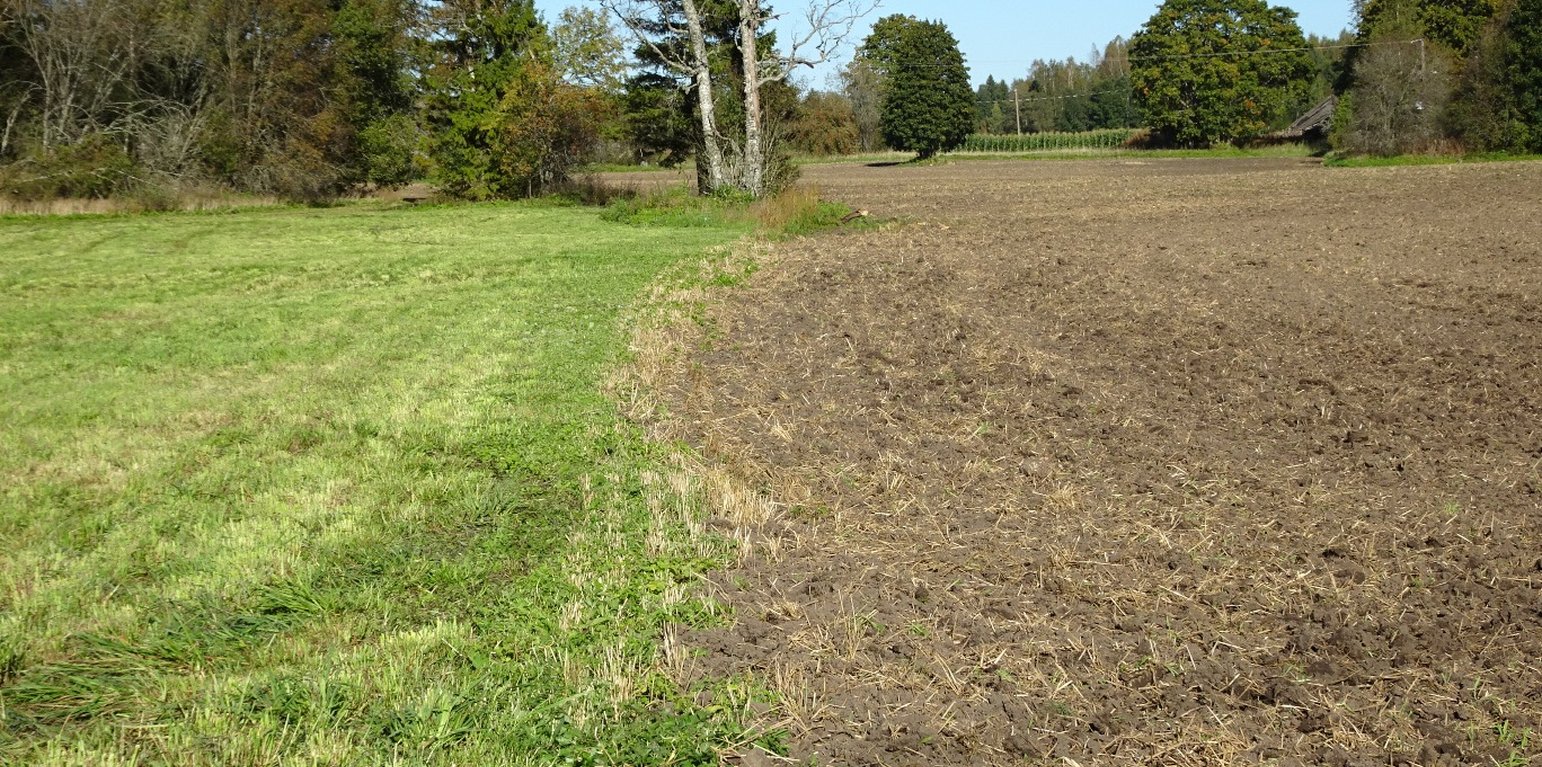



The technology is applied in sub-humid climate with an average of 696 mm of precipitations per year, from which more comes from July to October and less in March and April. Average annual temperature is +4 C, length of the growing period is 180-195 days. The territory is mostly flat to slopes of 6-10%. Average altitude from the sea level is 50 m. About half of the Estonian territory is above 50 m and half is below it. Soils are from very shallow (less than 0.1 m) inthe north to very deep (> 120m ) in the south. Soil cover is very variable. The peat cover of peatlands varies from 0.3 m to more than 10 m from well decomposed to poorly decomposed peat. On hilly areas the soils are medium textured with low (< 1%) organic matter in topsoil. Groundwater in near the surface in peatlands and deep in hilly areas. Biodiversity of these areas is medium. Market orientation of production system is mixed and off-farm income less than 10%. Relative level of wealth is average from individual households to cooperatives. Soil management is mechanized. Land belongs to land users but is leased also in case of bigger farms (over 1000 ha).
In the agricultural land the area will be excluded from intensive tillage by establishing a permanent plant cover, mainly with grass. The aim is to protect the slopes over 10% against erosion and peaty soils from further intensive decomposition of organic matter and with that the reduction of CO2 emission. The farmers should maintain permanent plant cover in the areas mentioned, or establish permanent plant cover. Renewing of the grassland is allowed from the top (without ploughing) once in a 5 year period. Government pays support of 50 EUR/ha if the area is bigger than 0.3 ha. The technology reduces intensively tilled area and thus the possibility to grow cash crops and/or reduces the yield from grassland. On the other hand it allows to still use wet areas for agriculture (i.e. fodder production).
The rules of the technology are fixed with the Estonian Rural Development Plan (ERDP) for 2014-2020 under activity "Support for regional soil protection" (https://www.agri.ee/et/eesmargid-tegevused/eesti-maaelu-arengukava-mak-2014-2020) related to the reguation of the European Parliment and of the Council 1305/2013, article 28. The regulation is relevant more to the South-Estonia in case to reduce erosion, as the landscape is more hilly there. The exclusion of peatlands from agricultural use is relevant more in West-Estonia where the share of peatlands of the total area is the highest. However, it can be applied in whole Estonia if the area of peatland is bigger than 0.3 ha.
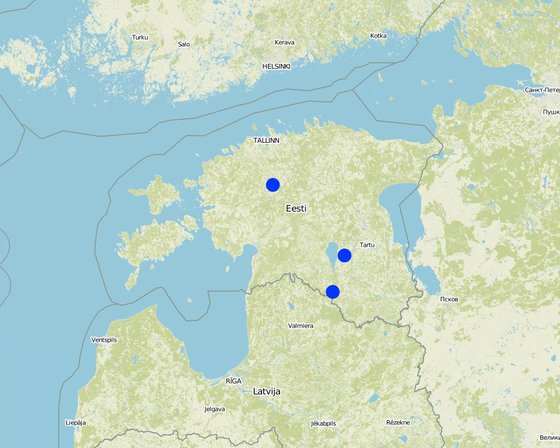
地点: One site: Rapla county, Pae; second site Tartu county, Annikoru, third site Valga county, Hummuli, One site at Rapla, second at Tartu, third at Valga (erosion), 爱沙尼亚
分析的技术场所数量: 2-10个场所
技术传播: 均匀地分布在一个区域 (approx. 1-10 平方千米)
在永久保护区?:
实施日期: 10-50年前
介绍类型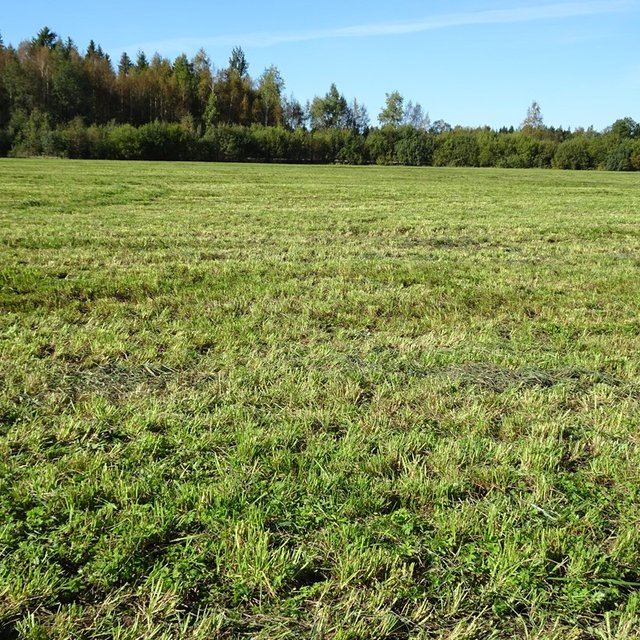
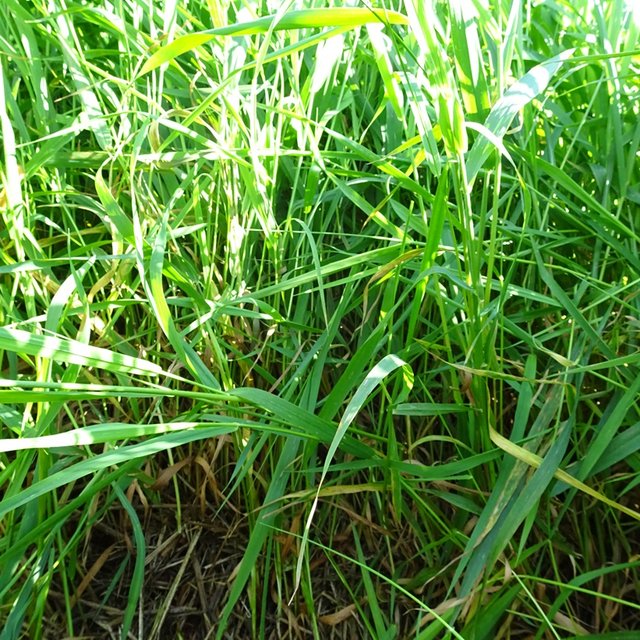









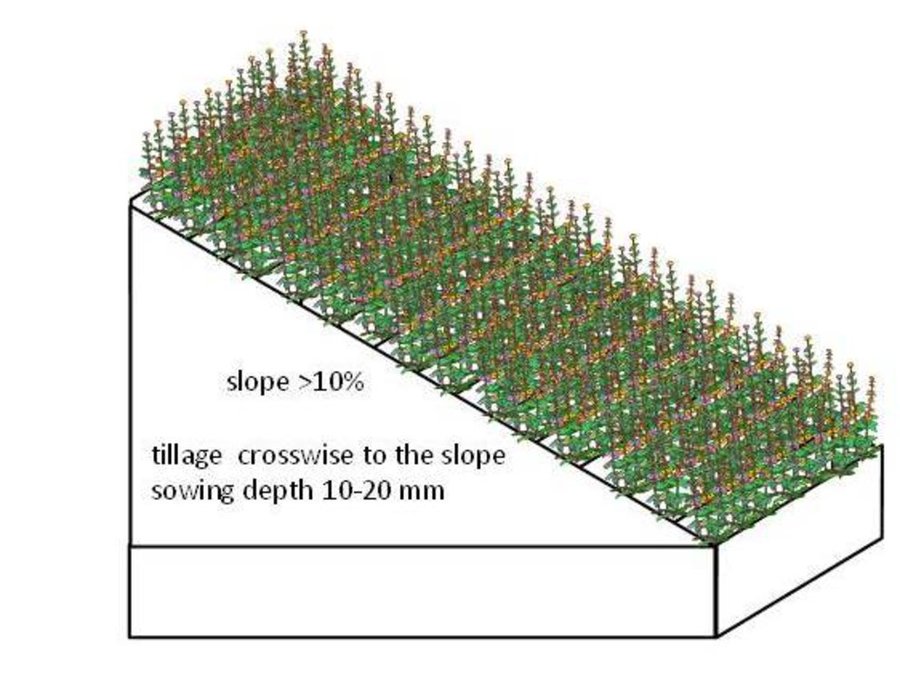
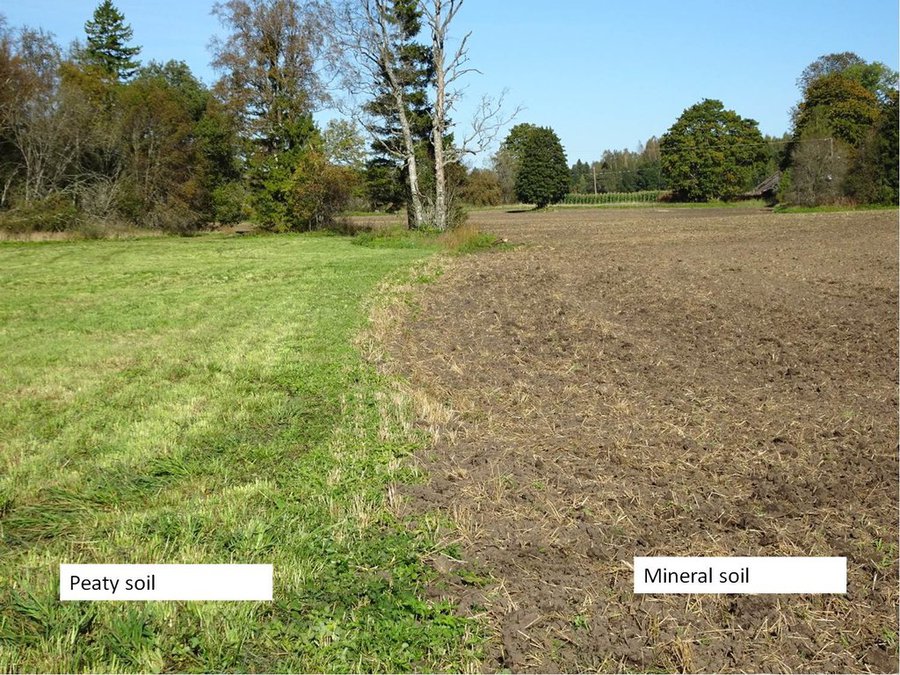
| 对投入进行具体说明 | 单位 | 数量 | 单位成本 (EUR) | 每项投入的总成本 (EUR) | 土地使用者承担的成本% |
| 劳动力 | |||||
| Driver (machinery work) | person day | 0.5 | 36.0 | 18.0 | 100.0 |
| 设备 | |||||
| Equipment (machinery) cost on establishment year | year | 1.0 | 207.0 | 207.0 | 100.0 |
| 植物材料 | |||||
| Seeds | kg | 22.0 | 2.47 | 54.34 | 100.0 |
| 肥料和杀菌剂 | |||||
| Complex fertilizer | kg | 500.0 | 0.42 | 210.0 | 100.0 |
| Ammonium fertilizer | kg | 100.0 | 0.33 | 33.0 | 100.0 |
| 技术建立所需总成本 | 522.34 | ||||
| 技术建立总成本,美元 | 442.66 | ||||
| 对投入进行具体说明 | 单位 | 数量 | 单位成本 (EUR) | 每项投入的总成本 (EUR) | 土地使用者承担的成本% |
| 设备 | |||||
| Grasslands for cutting - machinery costs | year | 1.0 | 141.0 | 141.0 | 100.0 |
| 肥料和杀菌剂 | |||||
| Ammonium fertilizer | kg | 200.0 | 0.33 | 66.0 | 100.0 |
| Complex fertilizer | kg | 200.0 | 0.42 | 84.0 | 100.0 |
| 其它 | |||||
| Materials for hay making | year | 1.0 | 15.0 | 15.0 | 100.0 |
| 技术维护所需总成本 | 306.0 | ||||
| 技术维护总成本,美元 | 259.32 | ||||
The area will be excluded from crop production and it means no cash crops can be cultivated on this area. Instead of crops hay or silage is possible to sell.
As it is not allowed to renew these grasslands intensively, the quantity of grass will drop. For short term clover+grasses mixture the average yield is 16 tons/ha per year, for long-term grass mixtures 5.2 tons/ha per year.
Due to the change of species in the mixture, the protein level will drop. Instead of red clover grasses will be used in the mixture of long-term grasslands.
Due to the changes in silage/hay quality (protein) there can be reduction of milk and meat production if the differences will not be covered with other fodder.
In case of crop orientation, there are new products to sell - grass, hay, silage, or grasslands to rent.
Depending on the farm it can be simplified or hindered. If focus was on crops, then new machinery is needed to manage grasslands (for cutting, hay or silage making).
As renewing of grassland is after every 5 years, there is no need to buy seeds every year, as well as pesticides and to till the soil.
Due to the reduction of the inputs costs, the income my increase. Also the government pays support 50 EUR/ha for the land under these measures.
Next to the yield (grass, silage, hay) the support from the government (50 EUR/ha)
It may decrease due to no need of every year tillage and sowing and due to the change from 2 year short-term grasslands to the permanent grasslands. However, if not managed grasslands earlier it may increase the workload as cutting and collecting the grass is needed.
More land under grasslands than under crops. Grasses are suitable for animals feeding, not for human direct consumption.
If land was eroded before and soil was on the road, everybody can see the differences after establishment of the grasslands. It is not so severe in case of peatlands, however, less tractors will stuck in to the mud on rainy period.
In case of erosion, no soil will be washed down to the hill as plant cover protects soil surface and increases infiltration. In case of peatlands, grass cover creates better structure and increases water infiltration thus decreases surface runoff during heavy rainfall.
Grass creates protection to the soil surface and raindrops can't destroy the soil structure any more. Also grass roots create better porosity and structure in the soil leading to better water drainage.
The difference in soil moisture between mineral and organic soils under cereals and under grassland was ca 5% and 25%, respectively, in favour to the grasslands in autumn 2016.
SLM之前的数量: 40%
SLM之后的数量: 100%
Under spring cereals soil is covered only 4-5 months per year, under grasses soil is covered 100% of the year.
On the slopes depending o the crop and the amount of precipitations, the loss varied from 3 to 60 tons/ha, under permanent grass cover it is less than 0.05 tons/ha per year. Without every year tillage there is no intensive decomposition of the peat, as well as no wind erosion.
Under grasses we can increase the soil organic matter content by 0.35 t/ha in 5 year period in peatlands. In eroded soils we can increase 0.02% per year.
As plants protect soil surface, raindrops can't destroy the soil structure and there will be no crust formation
Under the grasslands the bulk density was lower by 0.1-0.2 g/cm3 compared to tilled soil.
As the intensive decomposition of the peat stops or there will not be any leaching by water, more nutrients remain in the soil. Also the permanent plant cover during the whole year stops nutrient leaching.
Under permanent grasslands the Corg increases by 0.35 t/ha per 5 year period.
Without periodic liming the acidity of peatlands starts to increase. If no CaCO3 in mineral part, also pH of previously eroded soils starts to decrease slowly, as organic acids form during decomposition process.
Thanks to the permanent plant cover there is no period of the year without vegetation.
If previously the plant residues were mixed with the soil by tillage, now there will always some extent of plant mass be left above ground (5-10 cm), even if the most is removed for hay or silage.
Long-term grassland includes at least 4 species in the mixture, short-term mixtures 2-3 species. However, compared with the cereals, the annual weeds will disappear and the diversity may decline.
There are more spiders, ants, beets.
SLM之前的数量: 2 species of earthworms
SLM之后的数量: 3-4 species of earthworms
Under grasslands were 1-2 more earthworm species than under tilled management. More spiders and ground beetles were found there compared to the tilled soil.
Grasslands create untilled patterns to the landscape.
Grasses surpress many soil born crops diseases and pests, also annual and perennial weeds.
Grass roots go to the deeper soil and they are not so sensitive to the drought.
Under permanent grasslands reduced CO2 emission by 1.10 t/ha per year compared to the tilled areas.
If the grass will not be cutted before winter, the dry grass has the risk of higher landscape fires in the spring.
The changes of soil temperature as well as moisture content are smaller under permanent grass cover than under tillage.
All year plant cover helps to bind nutrients and stop their leaching from the soil. Higher amount of organic matter in the soil increases water holding capacity.
Organic peat particles are light and are easy subject of wind erosion in dry conditions by tillage. Permanent plant cover stops such kind of erosion
On hilly landscape no extra soil is flushed to neighbours fields. In case of peatlands no dust is carried around.
In case of erosion, no soil is carried by water or wind to the ditches and on the roads.
Under permanent grasslands reduced CO2 emission by 1.10 t/ha per year compared to the tilled areas.